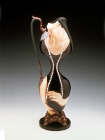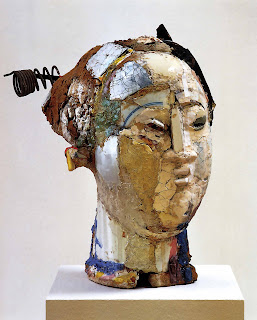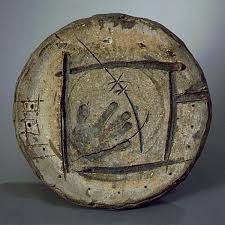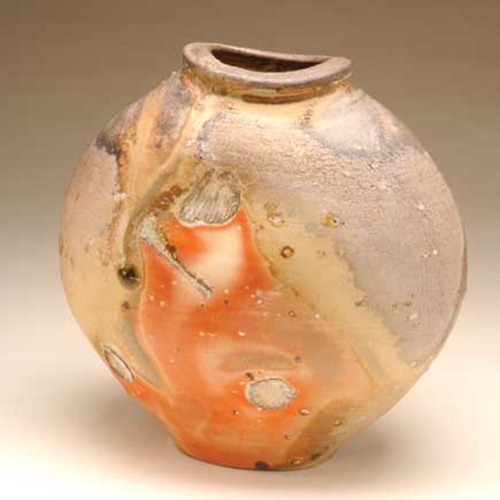
Arneson
In 1963 Robert Arneson made a distorted toilet that appeared to have been decorated by a pack of feral bathroom kids with very bad aim. Unlikely as it seems, the poop-covered toilet was a turning point for his work and created a new genre in ceramic art. He named the piece Funk John and thus it was that the new style of art was called “Funk”, or so the story goes. The problem with the name is that when most people think of “Funk”, the first thing that comes to mind is the music genre. Rather than thinking of sharp witted, satirical and often narrative art you are reminded of George Clinton and Bootsy Collins playing Flashlight dressed in garish, funkadelic costumes…well at least that’s what I think of.
Bootsy’s da man!
“Funk” is just one example in a long list of bad names for “movements” in ceramics. There are few enough contemporary clay artists doing noteworthy fine art that there is hardly a need for artificial categories. The names for these movements are generally invented by critics and promoters (Slivka, DelVeccio, Clark, etc.) in order, as they see it, to lend legitimacy to the work. “Funk” is typical of these names in that it does not describe the work very well, only covers the work of three or four artists and distracts from the true quality of the art. Bad as the name “Funk Ceramics” is, the notion of comparing music with ceramic art does have potential to shed light on what was being made by the artists in the last sixty years and why. Provided that the metaphor is not taken too far, the branch of the popular music scene in the U.S. which shifted from Jazz to Funk and then to Hip Hop mirrors the progression of ceramics from the late fifties to the present. Both were inspired by the same Zeitgeist and interestingly, the methods of composition and creation mirror each other as well. It is also significant that the way that culture is created in the face of modernity is similar to the way that both the music and art discussed here were made. Jazz musicians were not looking at artists and saying, “Hey! Let’s work the way they do,” any more than culture on a whole decided to behave like an improvising Jazz band . Society was acquiring new tools to deal with accelerated change and artists on the cutting edge were perceptive enough to express themselves in a mode that echoed the general manner of assimilation of modernity around them.
Improvisation


Voulkos Souldner

Mason
Cool Jazz and the work of Peter Voulkos, John Mason and Paul Souldner are a good place to start. Aside from being one of the most important ceramic artists of the twentieth century Voulkos was a musician. He even had his own Jazz band for a while so the comparison is natural. Rose Slivka was the first person who made this connection. The working style was fast and action oriented. The guys did a lot of improvising and playing off of each other’s ideas. They also borrowed concepts from other artists in much the same way a Jazz musician would play a standard. Improvisation and the concept of the standard are defining characteristics of both cool Jazz and of the early work of Voulkos, Mason and Souldner. If you went to a Jazz club in the sixties to hear Miles Davis play you would hear him perform a few of his own songs and some songs written by a number of other musicians. He might start a set with Blue In Green, which he wrote, then do Round Midnight by Thelonius Monk, then play Cantaloupe Island by Herby Hancock and so forth. No one would even think twice about it because that’s the way everyone did it. When someone laid out the architecture for a good song it became a standard and all the other great musicians of the time did their versions of that song. Musicians weren’t accused of being unoriginal for doing this because they were improvising something new and personalized within the structure of the standard. One song had the potential for infinite interpretation.
Improvisation is defined for the purposes of this essay as personalized and spontaneous activity within the boundaries of a set structure often involving others with whom ideas and possibilities can be exchanged. An incredible amount of skill and understanding of music theory are necessary for musical improvisation to be successful. A musician needs to know what notes and chords will sound right within the liner notes of a song and more or less stay within the rhythmic flow of the piece. The musician also needs to have the vocabulary of music mastered so well that it can become a seamless medium for personal expression. A visual artist must also have a highly refined command on technique and design theory for the work to be successful.
Like members of a band, Voulkos, Souldner, Mason and the boys (it’s too bad there were no girls in the group) would get together nights at Otis State and make work playing off of each other’s ideas and the concepts of artists they were interested in. Voulkos would check out a show by the sculptor Fritz Wotruba then go back to the studio and do an improvised piece off of the standard Wotruba created.


Fritz Wotruba Peter Voulkos
Later on he’d paint the piece in a style that was an improvisation on something similar to what De Kooning had done except for that it was new because he was doing it in a way no one had done before. John Mason would see what Voulkos was up to and do his own version of it. Working like this they would go through a vast number of variations and work through ideas. They would expound on and add to Picasso’s ideas then combine the outcome with ideas borrowed from traditional Japanese ceramics. The process was not unlike what Miles Davis was doing with Rodrigo’s music in Sketches of Spain. The music and art created in this way was rich, vital and original. Like a John Coltrane solo that hit every conceivable variation on a theme at double speed the Otis group worked through the vast scope of possibilities at a break neck pace.
Both the music and the art were responding to a larger cultural environment of evolution. Freshness was sexy and change quenched the desires of a hungry consumerist nation that had just hit a growth spurt. Modernity in the post war environment was a juggernaut that glutted itself on the growing economy and demanded a constant sense of newness in order to keep productivity on the rise. Television, the media, air travel and a global economy that was expanding at an ever increasing rate meant that new ideas and imagery were being introduced and assimilated like never before. The integration of new products and ideas functioned much like improvisation within the structure of a standard. The standard was something familiar and well liked that could be redone over and over each time a little differently. A culture with a broad framework of morality and ritual would take in and make its own an invention or concept that was imported from somewhere else or an individual would absorb a new product, fashion or idea in a manner that was personalized. A concrete example of this is the way that the German made VW Bus became an iconic part of hippie culture. The social significance developed independently of the manufacturer’s vision and was the expression of a culture that improvised its own idiom based on what was readily available. There is a parody between cultural, musical and artistic improvisation.
Make it Funky
As the Otis group disbanded each member started doing something new and working in a new direction. Voulkos continued deconstructing functional forms and his clay work became more or less standardized. He also started working in monumental scale with bronze. John Mason’s aesthetic taste became increasingly pared down and he began working with bricks to construct installations that explored simple geometric formations and patterns that commented on industrial and architectonic form. Souldner started experimenting with Raku and adapting his organic forms to a Japanese/ American hybrid aesthetic. The Jazz community also started to branch into new directions. Miles Davis for example began creating work that became increasingly experimental and chaotic in nature; dissonant noise, near chaos. Fragments of coherent music. Herby Hancock and Quincy Jones (among others) started fusing Jazz and Funk. In his first solo album Hancock introduced a song called Watermelon Man, and then during the seventies he released an album called “Head Hunters” wherein Watermelon Man is redone as a funk song. It’s easy to miss the catchy metropolitan melody of the original in the seventies-hip urban textured funk sound of the second version. Some musicians have implied that Hancock had sold out by making a funk album, but it was the product of an impulse triggered by a new environment that demanded a new way of communicating. The old modes of expression could no longer describe the feeling of the time and so it was necessary to make new ones for a culture that was addicted to change.
In 1961 Robert Arneson did a vessel with a cap over the lid that didn’t allow anything in or out. On the side of the piece he wrote the words “no deposit” and he titled it No Return. The piece expresses the inability of functional ceramics to articulate what he wanted to say and it hinted at his desire to do something else. After a stint of emulating the type of work created by the guys in the Otis group he decided to do something new. The last shove away from the free and easy vessel forms that he had been producing was an invitation to show work together with the guys from the long since canonized Otis group. He wanted to speak in his own voice not a borrowed one. This was when he did Funk John. Just as Hancock had fused his Jazz sound with funk in order to keep pace with the zeitgeist, Arneson started using representational imagery. It was necessary to leave the old style behind because it had lost its ability to speak to and about a changed world. Funk ceramics was outlandish theatrical and sharp witted while maintaining a tongue in cheek silliness that acted as thin insulation for deeper social commentary. The funk band Parliament did some similar things with their stage act. In their silly and bizarre productions which included space ships, garish costumes, lights and smoke they would make statements about the corruption of government, racial inequality and new coping methods for the oppressed. Parliament’s brand of urban Vaudeville has been quoted by the Hip Hop comunity not the least of whom is the group Outkast.
Another progeny comes by means of the fact that the funk music of the seventies is hands down the largest source of sampling among Hip Hop musicians today.
The style pioneered by Arneson has also sent echoes through contemporary ceramics. At the time it was being made some were unsure how to contextualize it. Historians and art promoters compared Arneson’s work to pop art in general and more specifically to Claes Oldenburg. There are certainly similarities and the intention of this was to legitimize the clay work, but the comparison detracts from some important and original contributions that were made by Arneson’s art. His work was telling stories in an art world that had temporarily anathematized narrative. The particular brand of satirical wit that would come to characterize Arneson’s work was distinct at the time but would be center and front for the next generation’s sense of humor. The cartoon like imagery that Arneson was doing at the time was uncommon and often misunderstood. Some considered it weird and a bit flippant for the often serious subject mater it took on. Arneson’s characteristic satire, sarcasm, multilayered irony and rope-a-dope faux-stupidity are a second language today. Some obvious examples of this are Saturday Night Live, The Daily Show and The Colbert Report but the list could go on and on. Today Arneson’s style of working is nearly ubiquitous among ceramic sculptors. In the 2008 NCECA invitational art show “Voices” almost every piece was cartoon-like, narrative, witty, and political. Most of the work had a direct line relating it to the work of Arneson and Gilhooly.
Arneson’s art also deals intimately with his sense of identity. In a series of sculptures Arneson represented his home, 1303 Alice Street in Davis, California, which he nicknamed Alice. These works deal with the artist’s sense of place and community as they relate to him. Arneson also explored his identity in the self-portraits that make up the bulk of his body of work. In Klown he sculpted himself as a deformed clown, then as a pottery kiln filled with self portraits in Kiln Man. In Captain Ace Arneson is a pilot who has been soiled by numerous birds while in a large drawing he portrays himself as the fallen and drowning Icarus. Robert Arneson’s work tells a story of his own struggle for a sense of identity through intense self-inspection.
Robert Arneson
It’s worth taking a moment for David Gilhooly. He doesn’t get as much attention as his mentor Robert Arneson, but there is something special about his work that needs to be recognized. Mathew Barney has received a lot of attention for creating a sort of alternative universe that can be strange and self absorbed while capriciously flowing in and out of cultural criticism and semi-allegory. David Gilhooly created an alternate universe that was quirky and original at least twenty years before Barney. Gilhooly’s frogs were benign and silly but spoke of darker issues. The real world often peeks out through the cracks in his inane frog world and catches you off guard. Arneson and Gillhooly had unique voices that still resonate today. As with Funk music the ceramic artists have been quoted again and again over the years.
Sampling the Mix, Bring that Funky Track Back
In 1989 Adrian Sax did a piece called Yo, Karnak. The pot is made up of a gold-colored, gourd-shaped upper section with a semi-fancy base that paraphrases the kind of motif you might see on a baroque vase. Snails cover the exterior and seem to crawl towards the crowned top. On the side of the piece the word “Yo” stands out in high relief letters that are near bronze in color. Anyone who hasn’t been living in a cave for the last twenty years knows that the word “Yo” is a vernacular term that means “hey” but can also mean other things like “hello” or “you’re about to get a serious beating”. The word was popularized by Hip Hop music and became a part of almost-everyday speech when MTV used it in the title of their all rap music show called Yo MTV Raps. The ceramic piece draws an interesting comparison between hip hop music and some strategies of communication that are commonly used in contemporary ceramics. In art we call these modes of expression quotation and pastiche; in Hip Hop it’s called sampling. Sampling in music is a direct descendant of the practice of improvising on a standard while in ceramics a similar lineage can be traced from the kind of borrowing that the Otis group did and the quotation and pastiche that have become postmodern mainstays.
The fabric of culture is formed in our postmodern lives through an eclectic sampling of products and images that are widely available. In the clothing industry for example there is constant borrowing from past fashions. These are reproduced with new elements and are often worn with a sense of irony in light of the historical reference. Hip Hop and other art forms including ceramics will often use a patchwork of outside elements that are fused in a new way and meshed together with a novel element that is entirely original. This is the same way that culture on a whole creates its self in our current global environment. As was the case with improvisation in Jazz music, Ceramics and culture in the sixties, there is a clear parody between sampling, pastiche and quotation, and the way that we create contemporary culture. The central difference between what happened then and what goes on these days is that the change is accelerated by a vastly increased exposure to new images and ideas. We have also become more self aware in our habits of quotation and it has become more sophisticated.
In a Hip Hop song an old Funk track may be paired up with a Hip Hop beat, new vocals and maybe some other elements like sound bites from movies and some record scratching. This is exactly what the Beastie Boys did in their 1989 song Egg Man. The track starts with a looped baseline that the Beastie Boys borrowed from the song Super Fly by Curtis Mayfield. They add on a new drum beat that makes the seventies original sound contemporary (for the late eighties anyway). The added on sounds and textures are important because they are what make the piece new and relevant. In ceramics the simple act of quoting a form or motif from a past movement is not a new idea. Around the turn of the century for example it was common for artists to make pieces that referenced historical styles. Two movements that are defined by this tendency are Historicism and Orientalism. Postmodern quotation differs from these movements in that the act of quoting is not intended solely to showcase the skill and sophistication of the artisan as was the case with the previously mentioned genre. A contemporary artist’s intention is more likely to make a piece that borrows historically established vocabulary in order to articulate a new idea. Meaning and method go hand in hand so it is necessary at this point to explain both.

Cindy Kolodziejski
In Pearl Necklace (1999) by Cindy Kolodziejski an hourglass-shaped Victorian pitcher form is put to work as a means of discussing the historical oppression of women. The foot and handle are elegantly ornamented and the body of the pitcher narrows to an almost obscenely slim width at the middle. On one side of the pitcher is an image of a very thin woman wearing a black dress and a pearl necklace. The image and form call to mind corsets, starvation diets and other ways in which women inflict pain upon themselves to be fashionable. The functional pitcher form which would traditionally impart nourishment seems to be saying that the aggressively libidinal male appetite and gaze are fed by the torture of women. On the flipside of the piece is an image of a phallic cucumber which is thin in the middle like a girdled waist line. A hand grips the base of the cucumber while the other hand skins it with a vegetable peeler. The image clearly indicates aggression towards men. It seems to ask the question of men, what if we made you do the sorts of things that you make us do? The use of a Victorian form as the vehicle for this statement calls to mind the recurrence of oppression and inequality throughout history.
Hip Hop also uses historical references in order to communicate new ideas. In Rock and Roll 2 the group Handsome Boy Modeling School juxtaposes a contemporary Hip Hop beat against sound bites taken from Antonio Vivaldi’s The Four Seasons. The song touches on a smattering of issues, with the typical posturing bravado that seems to seep through the cracks of every rhyme in Hip Hop. The main theme is how Rock music influenced Hip Hop and “Hip Hop influenced the world“. The use of Vivaldi’s music in this setting is interesting because it invokes in the mind images of stodgy European high culture. This is layered together with a sound from what at one time may have been seen as its opposite. When considering the influence of Hip Hop culture on the world it is hard to deny its legitimacy as an expressive medium. Hip hop artists assert themselves as the new high culture and conspicuous aristocracy-nouveau…hence the fancy pants classical sound paired up with an urban beat.
Another example of a historically referential work in ceramics that discusses contemporary issues is Playmates, 2007, by Pavel Amromin. This piece appears in the catalogue for the 2008 NCECA show Voices and is one of those Arneson offspring that I spoke of earlier. In Playmates a pink skinned puppy dog faced figurine dressed only in black military boots awkwardly points a rifle at his bound prisoner who is also a naked puppy dog soldier. The gun toting soldier seems to be posing for a photograph with one foot holding his POW’s head down. The captor wears a smile that is absurd considering the gravity of what is happening. The image alludes to a group of widely circulated photographs from the Iraq war wherein young pink faced American soldiers smile triumphantly (and inappropriately) while their prisoners are being forced into humiliating and often obscene positions. The piece is small (9”x8”x5“) and mimics European porcelain figurines like those made at Meissen, Sevres and Chelsea among others. The color scheme, ornate base and figure gesture all mimic a style of work that one would expect to see in the home of the very wealthy.
The irony being expressed in the piece is layered. First is the reference to the general youth and inexperience of soldiers in Iraq, Afghanistan, and the myriad other places where lives are taken and lost every day. Inexperienced soldiers who are almost children are placed in situations where the wisdom and good judgment that come with age couldn’t be more needed.
The second irony expressed in Playmates is spoken through the historical reference. Especially in Iraq it is difficult to uphold the expedience of our invasion in light of the debunked “intelligence” that was used as its justification. Many have suggested that the war was motivated by corporate interests who stood to make a very large profit. This essay does not propose to prove or disprove such accusations, but it is undeniable that for many wealthy and powerful people war is a means of earning an obscene amount of money. The style mimicked in Amromin’s piece is one that was engineered to appeal to the wealthy and powerful of Europe principally in the seventeen hundreds. These people were insulated from the colonial horror that generated their wealth, yet their lifestyles and decisions determined the outcomes of numerous lives. A part of this insulation was created by the insouciant and decadent art (cute porcelain figurines and so forth) that furnished their dwellings. Though we pretend to have overcome the evils of imperialism the wealthy and powerful are still far removed from the conflicts that generate their wealth. At least now some of the art work that our culture generates is willing to bite back.
In music two offspring of sampling are biting and mash up. Biting sound bits from anywhere you could imagine is common in nearly all genre of popular music these days. Sometimes this is done to make a point and sometimes the sound bite is thrown in there just because it fits the flow of the song. A break off idea that was born of sampling is “mash up” music. A mash up is when the vocals of one song are played against the music of another one. Often the two songs that get mashed are from very different genre. A good example of this is a mash up album done illegally by the artist Danger Mouse. He took music from the Beatles’ white album and coupled it with the lyrics and beat off of the rap artist Jay Z’s Black Album. Danger Mouse entitled it The Grey Album.
Mash ups are common in ceramics. An example of this is Acid Toby, 1993 by Richard Slee.

Richard Slee
The piece mashes a contemporary kitsch yellow smiley face with the historical kitsch Toby jug form of 1800 England. The historical jug was a representation of a legendary drinker nicknamed Toby Fillpot who could drink ridiculous amounts of alcohol. The yellow smiley face on the new version of the Toby jug and the title point at the new ways in which people intoxicate themselves (acid, heroin, cocaine, ecstasy, etc.). Because Fillpot and the Toby jug motif are part of English history the piece can be read as a cultural critique upon the English. Slee’s piece seems to be saying that although there are new substances to get trashed on little has changed in English substance abuse.
Ceramic artists also do something similar to the musical practice of biting sounds. The work of Gertraud Mohwald is a good example of this.
Gertraud Mohwald
Mohwald will take shards from broken ceramic vessels and sculptures and use them to form her pieces. Her serene countenanced figures are avatars of a global culture that builds itself from the bits and pieces it finds to suit its needs. These cultural shards are easily gathered through a number of modern media.
No medium of information-propagation has broken down culture into bits quite like the internet. With a few mouse clicks a person can encounter information and imagery from nearly any conceivable aspect of world culture. Fashion, music, art, sports, etc.; if people are interested in something they can probably find it neatly broken down into abbreviated blurbs, sound bites and video clips on the internet. These fractured elements are often relatively free of context and can easily be mashed up with a new cultural backdrop. We live in a broken-down-and-pieced-together-mash-up world where artists, musicians, cultures and individuals assimilate new ideas and elements through improvisation.
The acceleration of recurrence and re-appropriation of cultural shards is what defines contemporary global culture, music and art. Amid all this recurrence there are echoes of improvisation and signs that the standard though distorted is still knit tightly into our social fabric. In music and ceramics this is easy to find. Gershwin’s old standard Summertime comes up again and again in music. As a Jazz tune, then as a Rock song in Janice Joplin’s version, later as a Hip Hop song by Sublime, and once again as a Jazz song played by Herby Hancock and Joni Mitchell. In ceramics an interesting line can be traced from the punctured platter forms that Luccio Fontana did to the somewhat more organic and Japanese platters that Peter Voulkos made, then down to those done by Don Reitz and finally to the more urban and political platter forms done by Niel Tetkowsky. In world culture you might expect that all the sharing of ideas would create a homogeneous world culture but this is not the case. The reason why cultures maintain a unique identity in the face of change is that the absorption of modernity is achieved through improvisational incorporation of new elements within the standard structure of the already existing cultural heritage. At this point improvisation, adjusting style to keep up with change, sampling, biting, mash up and their artistic and cultural counterparts are difficult to separate from one another. Rather than a world of demarcated borders and neatly defined categories we inhabit one of fractured bits of information that shift in a constant state of flux. Its form in the elusive present is the world we live in but it won’t hold still long enough for artificial categories to stick to the constantly distorting structure.
.jpg&t=1)

Luccio Fontana Peter Voulkos


Don Reitz Niel Tetkowski




 Shiro Tsujimura
Shiro Tsujimura 




